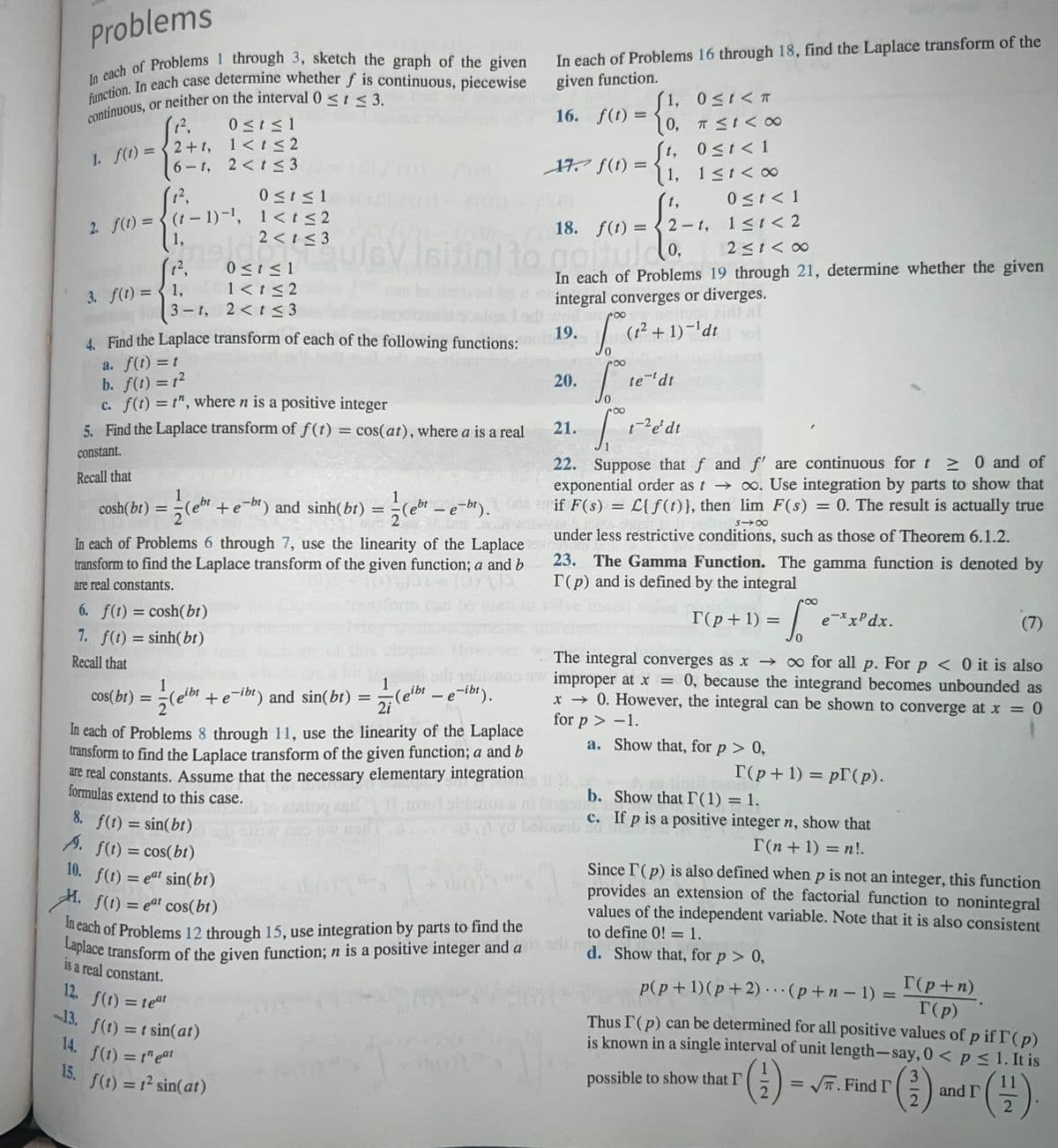Calculus: Early Transcendentals
8th Edition
ISBN:9781285741550
Author:James Stewart
Publisher:James Stewart
Chapter1: Functions And Models
Section: Chapter Questions
Problem 1RCC: (a) What is a function? What are its domain and range? (b) What is the graph of a function? (c) How...
Related questions
Question
13 help

Transcribed Image Text:Problems
In each of Problems 1 through 3, sketch the graph of the given
function. In each case determine whether f is continuous, piecewise
continuous, or neither on the interval 0 ≤ t ≤ 3.
(1²,
1. f(1) = 2+1,
0≤ t ≤1
1<t≤2
2<t≤3
6-1,
(1²,
2. f(t) = (t-1)-¹,
3. f(t) =
1,
meldets
1²,
0 ≤t≤1
1<t<2
1,
3-t, 2 < t ≤3
0 ≤t≤1
1<t≤2
6. f(t) = cosh(bt)
7. f(t) = sinh(bt)
Recall that
2 < t ≤3
4. Find the Laplace transform of each of the following functions:
a. f(t) = t
b. f(t) = 1²
c. f(t) = t", where n is a positive integer
5. Find the Laplace transform of f(t) = cos(at), where a is a real
constant.
Recall that
cosh(bt) = ½(eb¹ + e-b¹) and sinh(bt) = ½(ehr – e-bt).
-
In each of Problems 6 through 7, use the linearity of the Laplace
transform to find the Laplace transform of the given function; a and b
are real constants.
8. f(t) = sin(bt)
A. f(t) = cos(bt)
f(t) = 1² sin(at)
=
In each of Problems 16 through 18, find the Laplace transform of the
given function.
16. f(t) =
10. f(t) = eat sin(bt)
1. f(t) = eat cos(bt)
In each of Problems 12 through 15, use integration by parts to find the
Laplace transform of the given function; n is a positive integer and a
is a real
constant.
365
12. f(t) = teat
-13. f(t) = t sin(at)
14. f(1) = theat
15.
17. f(t) =
={{
20.
1, 0≤t< T
0,
to normido.
2≤1<∞0
In each of Problems 19 through 21, determine whether the given
integral converges or diverges.
worl.wroo
19.
(1²+1)-¹dt
21.
18. f(t)=2-t,
0,
1,
t,
foc
S
To
π≤1<∞
0 ≤ t < 1
1≤t<∞
te ¹dt
fredi
t-² e' dt
0 ≤ t < 1
1≤t <2
22. Suppose that f and f' are continuous for t≥ 0 and of
exponential order as t→∞. Use integration by parts to show that
if F(s) = L{f(t)}, then lim F(s) = 0. The result is actually true
§18
under less restrictive conditions, such as those of Theorem 6.1.2.
23. The Gamma Function. The gamma function is denoted by
T(p) and is defined by the integral
(7)
apler.
The integral converges as x → ∞ for all p. For p < 0 it is also
1
cos(bt) = (eibt + e-ibt) and sin(bt)
di bien sw improper at x = 0, because the integrand becomes unbounded as
(eibt - e-ibt).
x → 0. However, the integral can be shown to converge at x = 0
2i
for p > -1.
a.
In each of Problems 8 through 11, use the linearity of the Laplace
transform to find the Laplace transform of the given function; a and b
are real constants. Assume that the necessary elementary integration
formulas extend to this case.
dog asd
T(p+1) =
Show that, for p > 0,
1 ex.
I(p+1) = pr(p).
e-xxPdx.
b. Show that I (1) = 1.
c. If p is a positive integer n, show that
T(n + 1) = n!.
Since I'(p) is also defined when p is not an integer, this function
provides an extension of the factorial function to nonintegral
values of the independent variable. Note that it is also consistent
to define 0! = 1.
d. Show that, for p > 0,
p(p+1)(p+2)(p+n-1) =
possible to show that I'
Thus I (p) can be determined for all positive values of p if I (p)
is known in a single interval of unit length-say, 0 < p ≤ 1. It is
3
2
()
2
=
T(p+n)
T(p)
√. Find I
(1/1).
2
and r
IT
Expert Solution
This question has been solved!
Explore an expertly crafted, step-by-step solution for a thorough understanding of key concepts.
Step by step
Solved in 3 steps with 3 images

Recommended textbooks for you

Calculus: Early Transcendentals
Calculus
ISBN:
9781285741550
Author:
James Stewart
Publisher:
Cengage Learning

Thomas' Calculus (14th Edition)
Calculus
ISBN:
9780134438986
Author:
Joel R. Hass, Christopher E. Heil, Maurice D. Weir
Publisher:
PEARSON

Calculus: Early Transcendentals (3rd Edition)
Calculus
ISBN:
9780134763644
Author:
William L. Briggs, Lyle Cochran, Bernard Gillett, Eric Schulz
Publisher:
PEARSON

Calculus: Early Transcendentals
Calculus
ISBN:
9781285741550
Author:
James Stewart
Publisher:
Cengage Learning

Thomas' Calculus (14th Edition)
Calculus
ISBN:
9780134438986
Author:
Joel R. Hass, Christopher E. Heil, Maurice D. Weir
Publisher:
PEARSON

Calculus: Early Transcendentals (3rd Edition)
Calculus
ISBN:
9780134763644
Author:
William L. Briggs, Lyle Cochran, Bernard Gillett, Eric Schulz
Publisher:
PEARSON

Calculus: Early Transcendentals
Calculus
ISBN:
9781319050740
Author:
Jon Rogawski, Colin Adams, Robert Franzosa
Publisher:
W. H. Freeman


Calculus: Early Transcendental Functions
Calculus
ISBN:
9781337552516
Author:
Ron Larson, Bruce H. Edwards
Publisher:
Cengage Learning